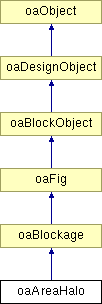 |
 |
 |
||||||
Inheritance diagram for oaAreaHalo:

 |
 |
Public Methods | |
| void | getOffsets (oaDist &left, oaDist &bottom, oaDist &right, oaDist &top) const |
| oaBoolean | isSoft () const |
| void | setOffsets (oaDist left, oaDist bottom, oaDist right, oaDist top) |
| void | setSoft (oaBoolean soft) |
Static Public Methods | |
| oaAreaHalo * | create (oaBlockObject *owner, oaDist left=0, oaDist bottom=0, oaDist right=0, oaDist top=0) |
| oaAreaHalo * | find (const oaBlockObject *owner) |
The area halo is most commonly used to prevent standard cells from being placed within a certain range of an instance. This is usually done to make sure there is enough space to properly route to the (presumably) large number of pins on the side of a block.
Note that the oaAreaHalo object officially supports rectilinear boundaries only i.e. the owner, if it is an oaPRBoundary object should represent a rectilinear figure, or, if it is an explicit instance, the singleton oaPRBoundary for the instance master should be rectilinear. Clients can use an oaAreaBlockage object to describe a halo with a fixed shape which can be rectilinear or non-rectilinear.
|
||||||||||||||||||||||||
|
This is the constructor for an area halo. Only one area halo can exist per owner object. Attempting to create multiple area halos on an object will result in an exception being thrown. Note that the left, bottom, right and top halo offset values should be specified relative to the respective edges of the prBoundary in the master. When an instance is transformed, the edges of the instance’s halo follow the edges of the prBoundary, regardless of whether the owner of the halo is the prBoundary or the instance.
|
|
|
This function returns the area halo for the specified owner if one exists.
|
|
||||||||||||||||||||
|
This function returns the offsets for the halo of the blockage
|
|
|
This function gets the soft attribute for this derived blockage.
|
|
||||||||||||||||||||
|
This function updates the offsets for the halo of the blockage
|
|
|
This function sets the soft attribute for this derived blockage. A halo with this attribute indicates that standard cells should not be placed within the halo, but later optimization phases can use the halo area.
|

Copyright © 2002 - 2010 Cadence Design Systems, Inc.
All Rights Reserved.